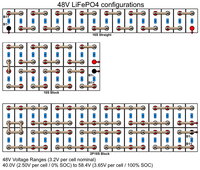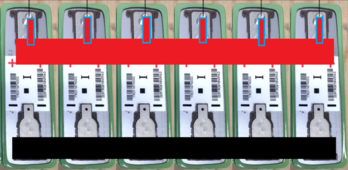Thank you for reading, I apologize for the book but I want to make sure all the information is there for reference.
With the surface area of the roof, I will be able to get 80x 250W panels. This will provide 20 kWh of power at peak saturation. The solar panels will be connected in the following configuration. 4x 10S2P. This will have an output of 303V and 16.54A at peak saturation. The panels will be connected to the 450V/200A Victron Solar Connection Kit (5011W per tracker). I will be using the Victron 20kVA Industrial Off-Grid Power System (2x 10kVA Quattro inverters,1000A Lynx Shunt, 1000A Lynx power in, 1000A Lynx Distributor, Cerbo GX). As for batteries, I am making my own packs using 528 LEV60F LiFePo4 3.2V 74Ah batteries. Parameters set at 10% - 90% SoC which will hopefully ensure longevity as they are never fully charged or fully discharged. My average daily usage over 2023 was 31.84 kWh (Peak of 43.91 kWh, low of 21.79 kWh). This systems gives me a little over 3 days of usable power on average with worst case scenario being 2 days and best case being just shy of 5. All components will be housed inside in a climate controlled room (~68F/20C).
I am looking to arrange my batteries in 16S33P. Basically I will have 16 rows of batteries. Each row will be 33 batteries in parallel with the positive terminals on top and the negative terminals on the bottom. The bus bars will support up to 40 batteries however for my use-case I will only be using 33 batteries per row. Main positive of the pack will be top right, main negative will be bottom right. The positive and negative connections will meet in the middle 4 inches apart with the center of the wiring being at 52 inches (negative) and 56 inches (positive). This will effectively give me a single battery that is 51.2V 2442Ah. From what I have read doing (16S1P) and then putting a bunch of these batteries in parallel is not ideal. At small scales I have read parallel the cells, then put them in series. Then I look at bigger scales and it seems most (companies specifically selling products and individuals DIY) does the opposite, creates the desired battery voltage (12V / 24V / 48V....etc) and then puts those battery packs in parallel. However the most recent video I saw from DIY Solar Power with Will Prowse (from 4 years ago) showed him building a 12V battery, 2 cells in parallel then 4 of those cells in series.
Now for the questions I have. I am looking for a >=16S BMS that works at 3.2V or a better way to arrange the batteries. The Battery Management Systems I have been looking at state "...up to 48V (60V Max)". Would this work? Do I need a 3.2V specific BMS, if so, do those even exist? If this is not possible, how should I arrange the batteries? The utility closet they will be housed in is 9' 1" tall, 13' 6" long and 6' 0" wide. The batteries are 4.53in x 2.17in x 6.74in.
Video referenced above :
Example of a BMS I have been looking at : https://www.orionbms.com/products/orion-jr2-bms/
With the surface area of the roof, I will be able to get 80x 250W panels. This will provide 20 kWh of power at peak saturation. The solar panels will be connected in the following configuration. 4x 10S2P. This will have an output of 303V and 16.54A at peak saturation. The panels will be connected to the 450V/200A Victron Solar Connection Kit (5011W per tracker). I will be using the Victron 20kVA Industrial Off-Grid Power System (2x 10kVA Quattro inverters,1000A Lynx Shunt, 1000A Lynx power in, 1000A Lynx Distributor, Cerbo GX). As for batteries, I am making my own packs using 528 LEV60F LiFePo4 3.2V 74Ah batteries. Parameters set at 10% - 90% SoC which will hopefully ensure longevity as they are never fully charged or fully discharged. My average daily usage over 2023 was 31.84 kWh (Peak of 43.91 kWh, low of 21.79 kWh). This systems gives me a little over 3 days of usable power on average with worst case scenario being 2 days and best case being just shy of 5. All components will be housed inside in a climate controlled room (~68F/20C).
I am looking to arrange my batteries in 16S33P. Basically I will have 16 rows of batteries. Each row will be 33 batteries in parallel with the positive terminals on top and the negative terminals on the bottom. The bus bars will support up to 40 batteries however for my use-case I will only be using 33 batteries per row. Main positive of the pack will be top right, main negative will be bottom right. The positive and negative connections will meet in the middle 4 inches apart with the center of the wiring being at 52 inches (negative) and 56 inches (positive). This will effectively give me a single battery that is 51.2V 2442Ah. From what I have read doing (16S1P) and then putting a bunch of these batteries in parallel is not ideal. At small scales I have read parallel the cells, then put them in series. Then I look at bigger scales and it seems most (companies specifically selling products and individuals DIY) does the opposite, creates the desired battery voltage (12V / 24V / 48V....etc) and then puts those battery packs in parallel. However the most recent video I saw from DIY Solar Power with Will Prowse (from 4 years ago) showed him building a 12V battery, 2 cells in parallel then 4 of those cells in series.
Now for the questions I have. I am looking for a >=16S BMS that works at 3.2V or a better way to arrange the batteries. The Battery Management Systems I have been looking at state "...up to 48V (60V Max)". Would this work? Do I need a 3.2V specific BMS, if so, do those even exist? If this is not possible, how should I arrange the batteries? The utility closet they will be housed in is 9' 1" tall, 13' 6" long and 6' 0" wide. The batteries are 4.53in x 2.17in x 6.74in.
Video referenced above :
Example of a BMS I have been looking at : https://www.orionbms.com/products/orion-jr2-bms/
Last edited:




